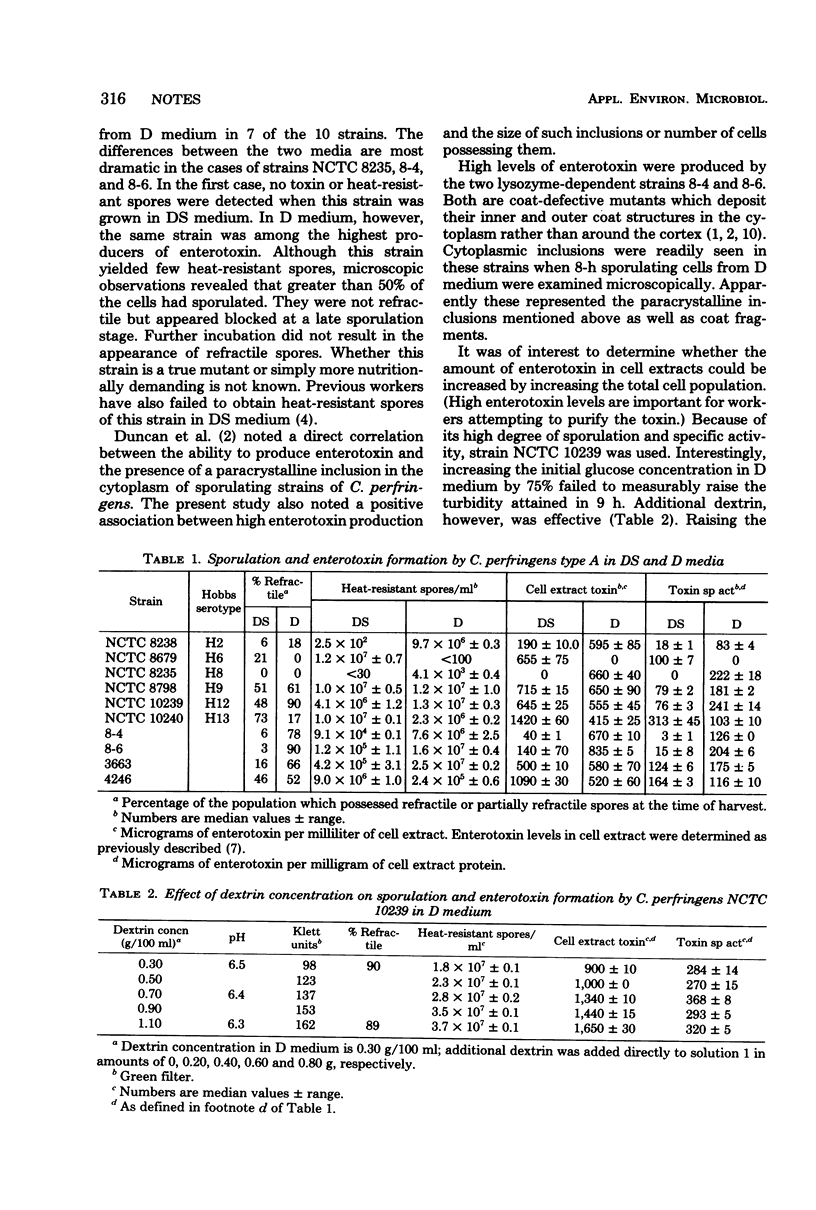Abstract
Enterotoxin was produced by 9 of 10 strains of Clostridium perfringens type A when grown in a defined medium. Additional dextrin increased the amount of enterotoxin in extracts of sporulating cells of strain NCTC 10239.
Full text
PDF


Selected References
These references are in PubMed. This may not be the complete list of references from this article.
- Cassier M., Ryter A. Sur un mutant de Clostridium perfringens donnant des spores sans tuniques à germination lysozyme-dépendante. Ann Inst Pasteur (Paris) 1971 Dec;121(6):717–732. [PubMed] [Google Scholar]
- Duncan C. L., King G. J., Frieben W. R. A paracrystalline inclusion formed during sporulation of enterotoxin-producing strains of Clostridium perfringens type A. J Bacteriol. 1973 May;114(2):845–859. doi: 10.1128/jb.114.2.845-859.1973. [DOI] [PMC free article] [PubMed] [Google Scholar]
- Duncan C. L., Labbe R. G., Reich R. R. Germination of heat- and alkali-altered spores of Clostridium perfringens type A by lysozyme and an initiation protein. J Bacteriol. 1972 Feb;109(2):550–559. doi: 10.1128/jb.109.2.550-559.1972. [DOI] [PMC free article] [PubMed] [Google Scholar]
- Duncan C. L., Strong D. H. Improved medium for sporulation of Clostridium perfringens. Appl Microbiol. 1968 Jan;16(1):82–89. doi: 10.1128/am.16.1.82-89.1968. [DOI] [PMC free article] [PubMed] [Google Scholar]
- Frieben W. R., Duncan C. L. Homology between enterotoxin protein and spore structural protein in Clostridium perfringens type A. Eur J Biochem. 1973 Nov 15;39(2):393–401. doi: 10.1111/j.1432-1033.1973.tb03137.x. [DOI] [PubMed] [Google Scholar]
- Labbe R. G., Rey D. K. Raffinose increases sporulation and enterotoxin production by Clostridium perfringens type A. Appl Environ Microbiol. 1979 Jun;37(6):1196–1200. doi: 10.1128/aem.37.6.1196-1200.1979. [DOI] [PMC free article] [PubMed] [Google Scholar]
- Muhammed S. I., Morrison S. M., Boyd W. L. Nutritional requirements for growth and sporulation of Clostridium perfringens. J Appl Bacteriol. 1975 Jun;38(3):245–253. doi: 10.1111/j.1365-2672.1975.tb00529.x. [DOI] [PubMed] [Google Scholar]
- Sacks L. E., Thomas R. S. High yields of coatless spores of Clostridium perfringens strain 8--6 in a defined medium. Can J Microbiol. 1979 May;25(5):642–645. doi: 10.1139/m79-093. [DOI] [PubMed] [Google Scholar]
- Sacks L. E., Thompson P. A. Clear, defined medium for the sporulation of Clostridium perfringens. Appl Environ Microbiol. 1978 Feb;35(2):405–410. doi: 10.1128/aem.35.2.405-410.1978. [DOI] [PMC free article] [PubMed] [Google Scholar]
- Ting M. N., Fung D. Y. Chemically defined medium for growth and sporulation of Clostridium perfringens. Appl Microbiol. 1972 Nov;24(5):755–759. doi: 10.1128/am.24.5.755-759.1972. [DOI] [PMC free article] [PubMed] [Google Scholar]


